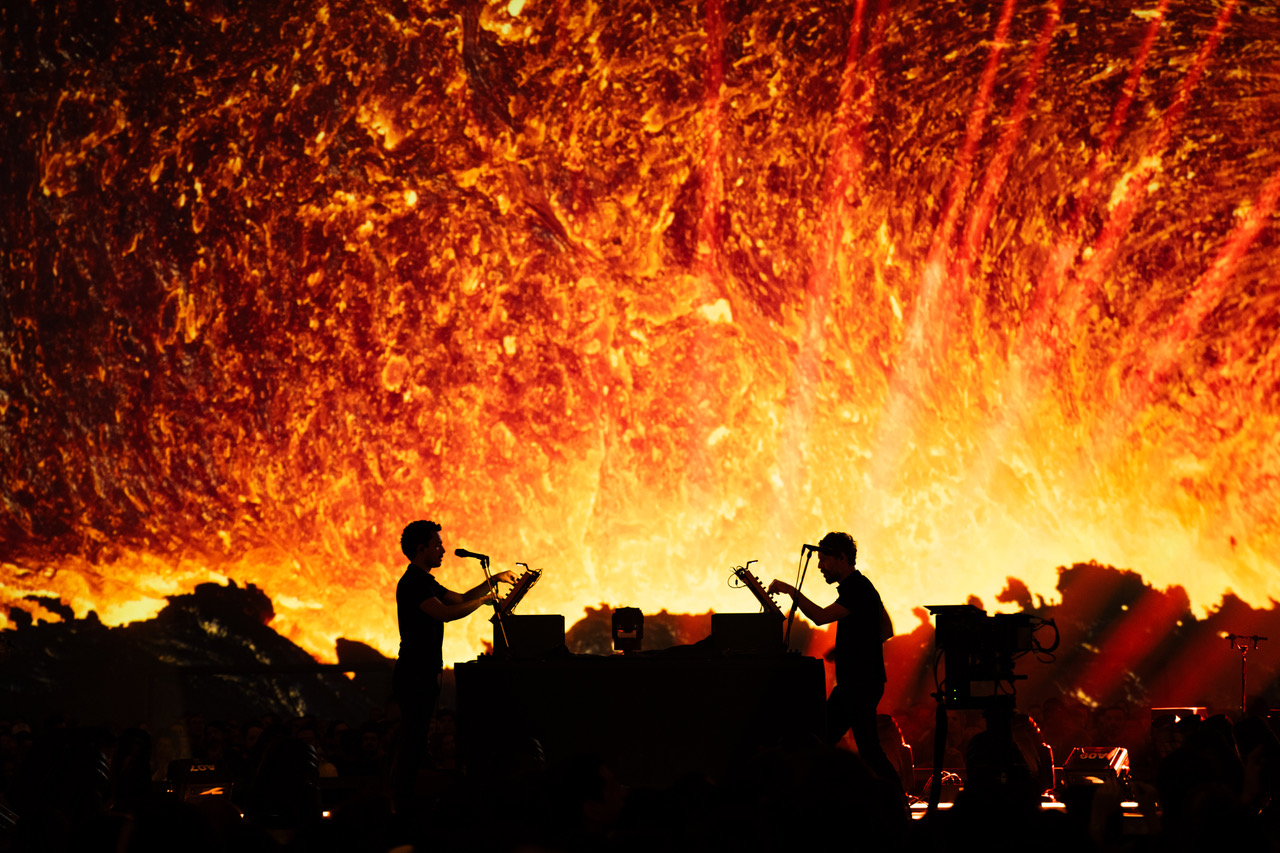Cercle, the innovative global music event company and record label, is taking live music to a new level with Cercle Odyssey, a series of nomadic immersive events visiting Mexico City, Los Angeles and Paris. The events are staged in giant concert spaces and feature performances by music artists surrounded by stunning visuals shot by director Neels Castillon (repped globally by Ridley Scott Associates) and projected on massive 40 foot by 180 foot screens. The scenography creates a panoramic window onto the planet, and plays as a backdrop for scenes from Homer’s epic Odyssey recreated by on-screen actors/dancers. Each concert is completely unique, and unfolds like a living painting.
Castillon, known for breathtaking ad campaigns for Hennessy, Cloe, Louis Vuitton and Meta, was tapped for the project by Cercle Founder and Creative Director Derek Barbolla. He spent the past year on location in the far corners of the world – the Namib Desert, Iceland, Polynesia and South America. Working with his Paris-based studio, Motion Palace, Castillon shot the visuals in 8K, creating a 20-hour film divided into 40 scenes, designed to play seamlessly across the five giant screens. For each performance, music artists curate different scenes from the footage, which means every night of Cercle Odyssey audiences see a different version of the film.
Odyssey lands at the Los Angeles Convention Center May 7, kicking off with Paul Kalkbrenner, followed by Empire of the Sun-May 8, Moby-May 9, The Blaze-May 10 and Black Coffee-May 11.
Egotist talked with Castillon about the odyssey behind filming Cercle Odyssey.
EGOTIST: You share a core belief with Cercle that art and nature are closely connected. When did you first discover this dynamic in your own work? Can you share an example or two of your commercials or short films that reflect this?
NEELS: Nature has always been a deep source of inspiration in my cinematic work. Over the years, I’ve developed a series of short films and music videos shot in remote, untamed landscapes around the world. I often blend the mediums of dance and nature to explore themes of harmony between humans and the Earth, and to reflect on scale—the intimate presence of the human body set against the vastness of our planet.
This artistic approach has naturally led advertising agencies to seek me out for commercial projects that echo the tone and visual language of my personal work. I believe F Major, which I directed in Iceland with pianist Hania Rani, is a strong example of this vision ~
HERE.
EGOTIST: We’ve covered some of your work as a commercial director, but you have also directed music videos. Who are some music artists you’ve collaborated with on music videos? Was your experience in music videos helpful when you undertook directing Cercle Odyssey?
NEELS: I’ve had the chance to collaborate with artists like Hania Rani, Ólafur Arnalds, Kiasmos and Angèle, to name a few. I see music videos as a brilliant playground for artistic experimentation—they’re a space where visual language can be pushed, reimagined and deeply connected to sound. I’m constantly inspired by music. The moment I hear a track, I begin to see images. Visuals take shape almost instinctively. That’s why I only take on music video projects when I truly connect with the music and when the artist gives me the freedom to explore creatively. This experience has taught me to shoot with agility, to craft bold and evocative visuals that serve the rhythm and emotion of the music. Most importantly, it’s taught me how to collaborate with artists—how to listen, respond and create a meaningful dialogue through image and sound.
EGOTIST: As a director of online and traditional content, what are some of the adjustments you made shooting a 360 immersive film? What was the hardest thing to get used to?
NEELS: In traditional filmmaking, you’re always thinking about how to fit everything into a single frame—you build a composition that gives meaning to the scene. But with this project, we had to imagine what was happening not just in front of the camera, but to the left, the right, above, behind—everywhere.
That completely changes the approach to directing. Still, I wanted to maintain a strong cinematic vision, a real point of view. So I started writing scenes where the screens interact with each other, where visuals echo and respond from one side of the room to the other. It’s a whole new level of complexity compared to a traditional shoot. You’re not just directing a scene—you’re managing a massive amount of spatial storytelling, and the production time multiplies.
Take Synchronicity, for example. It’s a scene where four dancers perform the exact same choreography simultaneously in four different corners of the world. Each is filmed with identical framing and camera movement. The result feels like you’re witnessing parallel universes—visually synchronized, yet emotionally distinct through their colors, atmospheres and landscapes. It’s mesmerizing, and deeply immersive.
Another scene shows a Ulysses character walking through a storm. He circles the entire space, pushing against the elements. The audience has to physically follow him with their eyes, which creates a sense of being inside the journey. And to take it even further, we built a custom 360° drone. It lets you dive into a waterfall or soar above the desert. When those shots play out in the venue, it feels like the entire room is moving across the planet. It’s not just a film—it’s a full-body experience.
EGOTIST: How did you get Cercle Founder and CD Derek Barbolla on board with making an immersive film inspired by The Odyssey?
NEELS: He’s the one who came to me with the idea! I just tried to bring a touch of storytelling and personal sensitivity to the visuals and color palette. I’m truly moved by his trust.
EGOTIST: Moby’s music is incredibly cinematic. You were instrumental in getting him on board. Did you and Derek see the possibilities from the start? How did you convince him? We heard you helped him with his setlist. Will there be any surprises for audiences?
NEELS: Derek kindly invited me to the meeting where we pitched the project to Moby. I think he felt the passion we both shared. What was supposed to be a 20-minute pitch turned into an hour-long conversation about cinema and music! I remember showing him a short teaser using his track GOD MOVING OVER THE FACE OF THE WATERS as an example. He told me he had never played it live before! I immediately said, “You have to—it’s my favorite song!”
Later, his agent asked me to suggest which tracks I’d love to see Moby perform during the set. So I created a playlist, and to my surprise, he approved it. With a few adjustments from him and Derek, it became the perfect show.
EGOTIST: The music lineup for Cercle Odyssey is amazing. Can you talk us through the process of how the music artists curated the footage for their performances?
NEELS: The goal was for me to direct a film several hours long, which now contains over 80 scenes. Each artist then works closely with Cercle’s Founder/Creative Director Derek [Barbolla] and Visual Curator Mathieu [Glissant] to curate their own show, selecting from the film to create a unique experience. Except for Moby—where I truly co-created the entire performance—I’m usually not involved in the selection process. I leave complete freedom to the Cercle team.
I’m actually very emotionally attached to the footage—each shoot was an adventure, filmed in some of the most incredible places around the world. That’s also why I step back. It’s my way of letting go, giving space for others to interpret the work freely.
It’s always a fascinating surprise to discover their choices during the live shows. The process is deeply collaborative, and once the film was finished, I intentionally removed myself from the equation to allow full creative freedom.
EGOTIST: We understand you have been filming the visual story for Cercle Odyssey for the past year. That’s a long time. What was your favorite place to film in? What do you miss most now that it’s behind you?
NEELS: Every location brought its own distinct energy — the golden dunes of the Namib Desert, the endless blue of Tetiaroa’s ocean, the untouched green of the Marquesas forests, and the stark, icy whites of the Icelandic Highlands. We even filmed on the Salar de Uyuni in Bolivia, a surreal, mirror-like expanse where earth and sky blur into one. It truly felt like stepping into a dream.
But the place that left the deepest impression on me was the forest in the Marquesas Islands. That connection went beyond the visual — it was deeply emotional. One day, local guides led us to a sacred site, normally closed to the public — a hidden valley beneath a towering waterfall. It took us four hours of trekking through dense jungle in pouring rain to get there. I was completely drained, physically and mentally. But just as we arrived, the clouds parted, and the sun broke through — transforming the rain into golden light that filled the valley. Our actress, Wan Lun, stepped into the scene and began dancing, framed by this breathtaking, ancient landscape. It was surreal. Later, during rehearsals, I saw how powerful that moment became in the immersive space. The audience didn’t just see it — they felt like they were there with us, standing under that same canopy. I miss this canopy!
EGOTIST: Any plans to document your experience as the filmmaker behind Cercle Odyssey?
NEELS: I started capturing moments on the side with my Leica. I’m currently working on an art book to create a tangible keepsake from this experience.







Comments